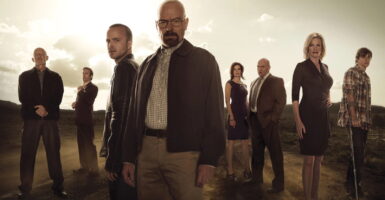Screenwriter Jon Spaihts Dishes On How His Version Of Prometheus Was Different
This article is more than 2 years old

Few recent sci-fi films have disappointed fans as much as Prometheus. There are reasons. Were expectations unrealistically inflated? Definitely. Are there large-scale design flaws in the story? To be sure. Does the film leave too many unanswered questions? “Too many” might be a matter of opinion, but you certainly walk away with a lot of loose ends. (Despite what this may sound like, and in spite of some rather glaring flaws, I rather enjoyed Prometheus.)
If screenwriter Jon Spaihts, who penned the first drafts of Ridley Scott’s Alien prequel, had his way, the finished product would have looked markedly different. Talking to Empire, Spaihts dished on his version of Prometheus, and some of the drastic changes that were subsequently made to his script.
One of the factors that led to him getting the job in the first place was the medpod scene. He was fascinated by the idea of a character, one infected with an alien embryo—and one who knew what was coming—surviving the process. With some slight alterations to the “choreography” of the scene, the arrangement and placement of events, Spaihts says the finished product is relatively similar to what he envisioned.
Over the five drafts that Spaihts wrote for Scott, they “were constantly toying with the closeness of the monsters in the film to the original xenomorph.” The trick was to make them similar enough that it was obvious they were family, but to leave room for evolution until they get to the point where they are in Alien. In the process they came up with eight different styles of creatures, all related, but all different in small but key ways.
He says they fidgeted with head shape and more:
We toyed with the notion that the xenomorphs might have a soft carapace like a soft-shelled crab, and be flexible and able to squeeze through cracks; that they might be pale rather than black; that they might retain inside some gelatinous cowl some resemblance of the human being in whom they’d incubated. We played with a lot of ghoulish notions like that.
According to Spaihts, Scott is quite the collector of “natural oddities,” and has a large photographic collection of horrific insects and creatures. These predilections and interests played into their creature designs.
The studio execs at Fox were more interested in creating a standalone property, rather than adding an additional film to the Alien canon. One of the key things Damon Lindelof was tasked with when he joined the production was “to replace the menaces of the xenomorphs with other things.” You see where they’re coming from, wanting something new, not a simple retread of a successful film series, but I could have used some more xenomorphs.
Spaihts’ version did include the iconic alien facehuggers. In his draft, David (Michael Fassbender) doesn’t infect Holloway (Logan Marshall-Green) on purpose. Holloway takes off his helmet, is knocked unconscious, and gets facehugged and impregnated.
[H]e [Holloway] returns to his cabin, is embraced by Shaw [Noomi Rapace], who is delighted to see him having feared that he had died, and the two of them make love. And it’s while they’re making love that he bursts and dies. So that lovemaking sequence echoed my original lovemaking sequence where he explodes! It was messy.
That’s, uh, a definite change from what appears on screen. Messy seems like an understatement. You can see why they cut that out, but god damn, how cool would it be to have that moment in the Prometheus? And you thought the mechanized cesarean section was memorable; think if there had been sexual chestbursting.
David (Michael Fassbender) was also a beast of a different sort in Spaihts’ drafts. At one point he would have handled a facehugger “like a kitten,” and he was also “a little more bloody-handed” in his betrayal of the crew. At the end of the script, he was left on the surface of the planet, with Shaw, and the two would have to come together if either wanted to survive. His ending was “very much about this shattered android and this scarred woman being left with no-one but each other to carry on with.”
From the beginning, the filmmakers went into Prometheus with an eye on churning out a franchise. With that end in sight, Spaihts had definite ideas on where he thought the story should go.
[His] vision of the trilogy would have involved the arrival of the Yutani Company and a couple of other major plays around the Engineers themselves: the revelation of an additional grand Engineer design, and the possibility of seeking an Engineer homeworld. That shot of the ship flying at the end offers a lot of creative ways to play with this. But it feels like it brackets you into the search for the Engineer homeworld and home civilization.
So what do you think? Do you like Spaihts’ version of Prometheus better than what was released in theaters? Could a bloody, chestbursting sex scene have saved the film? How about more xenomorph action? What do you think could have helped the film? Let us know in the comments.












